About Judy Walton:
Some folk artists learn their art by sitting at the knee of a long-time practitioner in their family or community. Some seek out a mentor who can introduce them to the cultural context of an art while also sharing the tricks of the trade. Still others follow a vision or passion and develop their art on their own through trial and error and with a dogged determination that cannot be deterred. Judy Walton of Lebanon County, PA has that passion for chip carving. She shared that passion with folklorist Amy Skillman and others at our 2024 Folk Artists Gathering.

portrait of Judy Walton by Amy Skillman
About Judy Walton
A Pennsylvania Dutch tradition
In the rolling farmlands and gentle mountains of central Pennsylvania, Judy Walton and her husband Stewart Walton carry on the Pennsylvania Dutch (Deutsch/German) folk art tradition of decorating everyday objects with meaningful designs based on faith, family, and nature. Their specialty is working with Pennsylvania Cherry, creating intricately hand carved, original artwork on selected pieces. They bring a contemporary interpretation to the tradition of woodenware by creating everyday objects in cherry wood and embellishing them with chip carving.
The items the Waltons make in their home workshop are the sorts of small objects that early Pennsylvania Deutsch farmers might have made for themselves out of wood: “stirring spatulas” of all sizes for cooking on a kitchen woodstove, little spreaders for jams, oven rack pulls, small food-boards, and that universal symbol of the Christian faith, the cross.
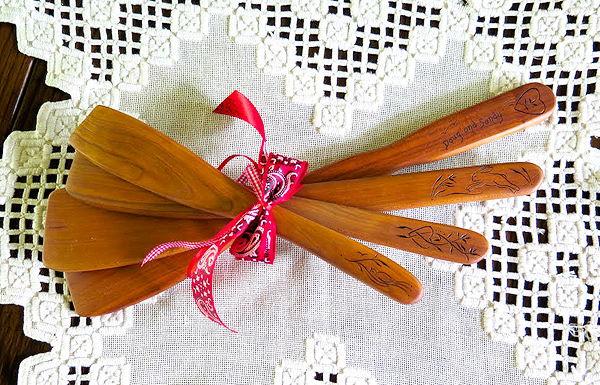
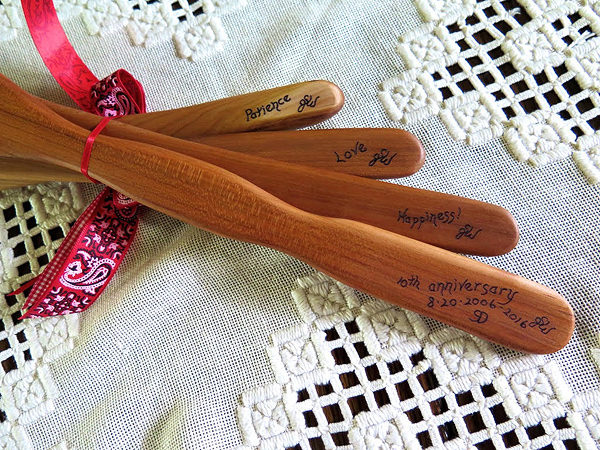
photos courtesy of the artist
Serendipity
When asked how she got into carving wooden utensils, Judy commented that no one had ever asked her that before.
“Well, here’s the story of my becoming fascinated with woodcarving on Pennsylvania Cherry (the only wood I use). I was famous for burning puddings and thick foods that I cooked in a pot. Then one day I was in a kitchen shop and saw a cherry wood stirring spatula from France. It was the perfect flat-bottomed tool for scraping the bottom of the pan, so food didn’t get scorched. It was absolutely perfect!”
And then one day Judy’s husband Stewart, who was making a cherry table for a friend, brought his wood scraps in to throw them into the woodstove. “Oh no!” Judy exclaimed. She is from the Midwest and considers cherry wood a treasure. “Please don’t burn the scraps. We can make something out of them.”

photo courtesy of the artist
Before long, they had collaborated to make some of those cherry stirring spatulas like the one from France. Stewart, like Judy, is self-taught. Stewart did the woodworking and Judy did the finishing work to make them food-safe. She says, “He makes all the items one by one and uses his own creativity to fashion unique shapes for the stirring spatulas and spreaders.” They gave them to friends and family and soon had enough orders to accidentally start a woodcraft business.
Judy notes that Stewart is also self-taught on the “musical saw”. He has been entertaining groups at churches, gatherings, and festivals for over 20 years. In 2009, he was part of a group of 52 people playing “Ave Maria” together on their musical saws at an event in New York City, which made its way into the Guinness Book of World Records!
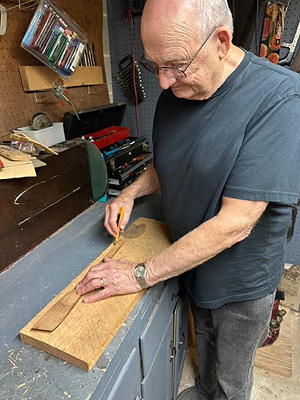
photo courtesy of the artist

photo courtesy of the artist
Inspiration to carve
A couple of years went by, and one morning Judy woke up with the idea that carving on the handles of the cherry wood utensils would be fun. “I went on the computer to find out how to do “chip carving” on cherry. There was nothing about it. I went to the library and searched. Nothing. Then I went to Philadelphia to see if that library had anything. Nothing. All the chip carving was done on other woods.”
Chip carving, or kerbschnitt in German, is a style of carving that uses knives or chisels to remove small chips of the material from a flat surface in a single piece. Typically, in wood working, it is done on basswood, butternut, pine, or mahogany — softer woods. The style is traditional in many countries, and patterns can be free-form or based on geometric figures.
“Failure. The wood was fighting me every smidgen of the way. But I kept trying because I was in love with cherry wood.”
Undeterred, she bought a knife and started carving. Judy was trying to do chip carving on a very hard wood. She explains, “Failure. I kept trying for a few weeks. Finally, I got a book about chip carving and discovered a much better knife. That helped. But the wood was fighting me every smidgen of the way. It had irregular fibers and would throw the knife. I kept trying because I was in love with cherry wood and thought that eventually I’d train my hand and wrist to deal with the wood. And, bit by bit, I did.”
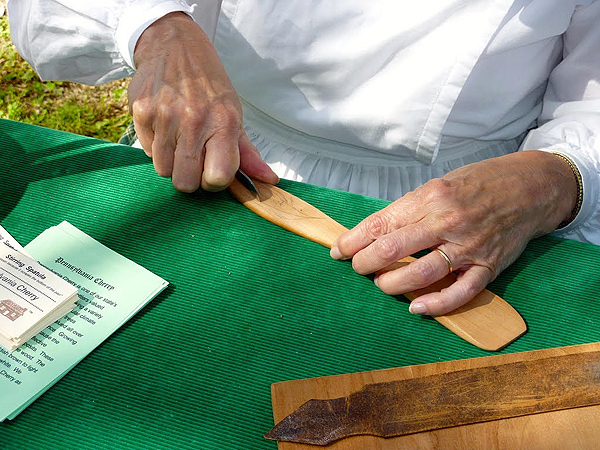
photo courtesy of the artist
Affirmation
One day a famous master chip carver came to Pennsylvania. Judy already had his books and the knife he invented, so she was eager to meet him and get his advice. At a woodworkers convention near Philadelphia, she took some of her work to show him. “He took my carved spatulas in his hands, regarded them thoughtfully... I was a nervous wreck waiting for him to say something.”
Then he smiled and said to her, “I don’t try to carve on cherry. It’s hard to work with. When I make a carved cabinet door, I do it on butternut wood and stain it to match the cherry cabinet.”
“Well, that made my day!“ Judy says. “I knew I was onto something, and I was having fun creating folkart on the handles.”
Inspiration seems to come to Judy in the night. She says, “A few years later, I woke up one morning with a compelling desire to do spiritual artwork on small crosses. My husband created the perfect size for me to be able to carve on the wood, and I added that to the things we made.”
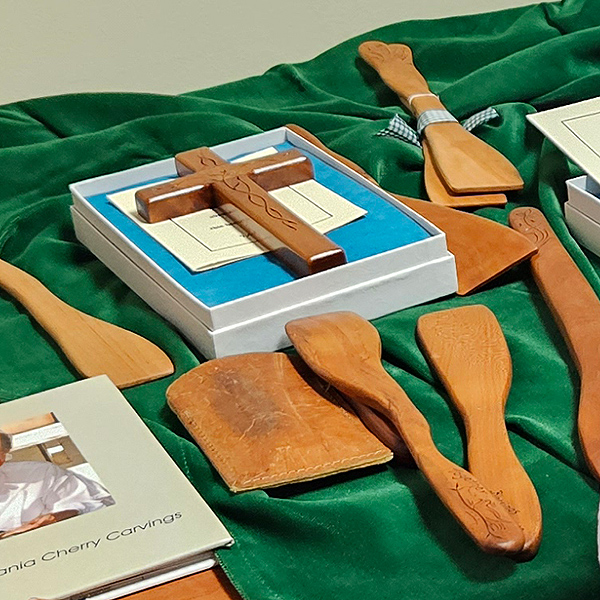
photo courtesy of the artist
A lifetime passion... and plenty to share
Judy and Stewart created cherry utensils for 20 years, and sold a lot of things at local historic fairs and in the museum store of the Historic Ephrata Cloister. One of their passions is to share the art and the life of those early Pennsylvania farmers with children through workshops, presentations, and the Schaefferstown Harvest Festival.
Recently, arthritis has limited their production, but they still love working with wood. “If I can help my hands do the carving again,“ Judy sighs, “I’d love to do a little bit more...” And if the opportunity arises to teach chip carving to others, Judy will jump at the chance.
“We’ve had a great deal of fun with our crafting over the years and we’ve met so many wonderful people!”
Photos and more information on Facebook: Waltons Homestead Furnishings
Contact Judy at waltonjs@verizon.net

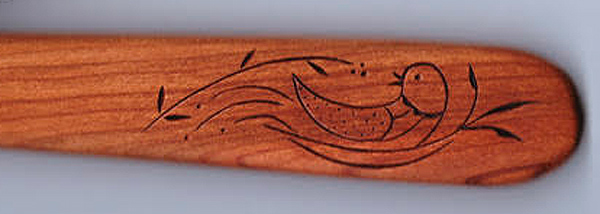
photos courtesy of the artist



Brand icons for Facebook, YouTube, Instagram and other social media platforms are the trademark of their respective owners. No endorsement is implied.